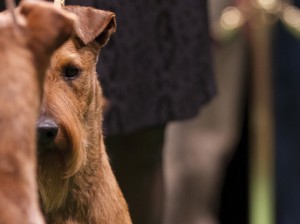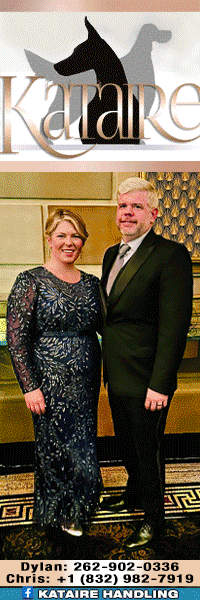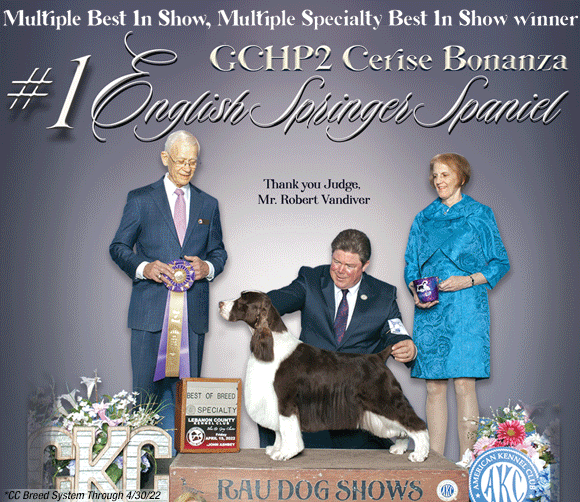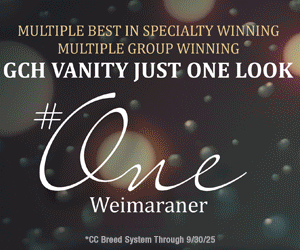From The CC Vault: O Judge Where Art Thou?
By Dr. Bob G Smith
Photo by Lisa Croft-Elliott
Originally published: August 2013 
Ever think about being a judge? Ever judged anything like talent shows, cooking contests, beauty contests, 4-H activities? From reading articles from different sources and from belonging to many dog show-related groups on social media, there appears to be a shortage of judges which is causing some show chairmen major problems.
From where is the next group of judges coming? Professional handlers? Breeders? Owner/handlers? Show Chairmen? Retired AKC staff? Roadside fruit stand and vegetable vendors? Circus performers? Some of those potential sources may seem far-fetched, but reality may set in soon and AKC may have to resort to some of those wild-hair sources for future judges.
Applying to become an AKC-approved judge does not happen overnight, nor after a month’s studying a breed, nor owning 42 dogs of a particular breed, and/or showing the top dog for the last millennium. Nor does experience alone a good judge make. Nor does experience alone qualify one to be designated as Permit in a breed, breeds, or group. Sometimes becoming a judge requires the luck of the draw, the smiles of the gods, the luck of the Irish, and whatever other good luck charm – Buckeye, rabbit’s foot, blood brother to the local Talisman – one can invoke. It is a combination of some or all of the aforementioned characteristics. But it also should include having an “eye for a dog” which will be discussed later.
I would encourage anyone thinking about judging to get as much experience in determining which is the best item, performance, etc., one can, regardless of the activity. A potential applicant, in my opinion, should have volumes of practice making decisions. The more experience one has in decision-making processes, the better prepared one can be to judge. That type of experience will not necessarily make one a better dog judge, but will prepare a person to deal with the pressures associated with judging.
Learning to evaluate is a difficult process for some. Being able to determine which is the “best item, specimen, or performance” when compared to a standard of excellence is a highly desirable skill sought after by many industries and critical for successful dog show judging. When one is able to discern the “best” as measured to a standard, that person could potentially qualify as a judge. That “dog person” is usually determined to have an “eye” for a correct dog. However, for many judges, “an eye” is developed only after years of interactions with dogs, especially one’s initial breed.
For years, I sat at ringside watching Cocker Spaniels being judged at Specialty, All Breed, National, and Spaniel club events. I watched breeder/judges, provisional judges, and multi- and all-breed judges evaluate Cockers. I decided that at each show I would be looking at a particular breed characteristic and/or hallmark—maybe a ‘tailset’ or balanced movement, or shoulder placement. I was in no way judging the judge. Ringside judging, in my estimate, is the worst kind of judging because at ringside, observers never get to feel the dog, have the viewing angles that the judge does, or can assess the temperament of the entry up close.
In my opinion, since each breed has multiple characteristics, it usually takes someone a long time to discern which tailset is closest to ideal as described in the standard; which arched neck is better for retrieving game from the bushes; or which size nostrils are sufficient for a dog to breathe while swimming with game in its mouth. These breed characteristics are usually not something an applicant can master by just reading the standard. It takes extensive observation, examination, and comparison—sometimes decades in the preparation process.
How does one develop an “eye” for a dog? What does that entail? The author of several dog-related books, Robert Cole, authored An Eye for a Dog: Illustrated Guide to Judging Purebred Dogs (2004) in which he wrote, “In judging dogs, you need to have formulated an image of “typical, i.e., conformity to the breed’s standard in your mind’s eye.” Cole continues, “You also need to have an awareness of the breed’s purpose, what it was originally bred to do.” This book, which Cole wrote and illustrated, is an excellent reference source for a potential judge to use to help develop an “eye for a dog. In it are multiple exercises to assist the reader in developing the eye required by successful dog judges.
An “eye” is not a trick, inborn trait, nor is it acquired quickly. It is often many years in the making. It is a deliberate process, in this author’s opinion. It requires focus and discipline to know what to look for, an understanding of all parts of the breed standard–what the structure looks like under the skin, what comparative traits are the central focus, what are the hallmarks of the breed; and what is the current definition or accepted definition of “type” or typically accepted idea of what a dog looks like that should be “Best of Breed”. Those are only parts of what a judge must be able to utilize to make a decision within the less than 2 minutes provided for assessing an entry. My belief is that if a judge does not have an eye for an ideal of the breed of a dog, the judging process often does not benefit the breed.
In my experience, when that type of judging occurs, mediocrity could ensue within the breeding programs for years to come based on what a judge has decided based on personal opinion and not educated evaluations. Upright shoulders and straight pasterns might be acknowledged as unwanted traits in a breed whose standard calls for a layback of shoulder and sloping pasterns necessary for the stretching and spring needed by sighthounds. When exhibits with those unwanted breed traits are awarded BOB, the unwanted perception that this is what the breed should possess becomes the basis for some breeders as being the “best” and consequently utilized in a breeding program. This is a simplistic example, but think of the number of litters than can be bred using a stud dog or brood bitch with poor shoulders and straight pasterns which produce puppies with poor shoulders and straight pasterns which in turn produce… etc., and etc.
Two other books that should be a part of any judge’s preparatory resources, in my estimation, are The Science and Techniques of Judging Dogs by the late Dr. Robert J. Berndt. Another resource is Rick Beauchamp’s Solving the Mysteries of Breed Type. Both are excellent books written by judges for judges and lay people. They should have a prominent place in anyone’s library whether they are used for preparation or an application to judge. Berndt’s book is an excellent treatment of all the aspects of judging from preparation to application to implementation. As Cole discusses, in addition to having an “eye” for a dog, judges must be able to discern which dog is closest to breed “type” on the day. Beauchamp does an excellent job of defining and illustrating “type” in his book.
My recommendation is that one read, re-read, and refer to those books frequently. They are excellent resources for applicants, permit, and approved judges. I also recommend them as great resources for anyone who breeds and/or handles dogs. The contents give non-judges excellent insight into what processes a judge might use in the ring.
Again, why would anyone want to judge? Why would anyone subject themselves to constant evaluation (sometimes called “harassment”) by exhibitors, by AKC, or by kennel clubs—possibly because we are gluttons for punishment, sadomasochists, or adults with poor self-concept? Any of the aforementioned would probably sabotage a promising judging career. Then, why judge?
On a personal note, my reasons for judging are mine! They are not intended to apply to or influence anyone’s reasons for judging. I chose to become a judge because I love my original breed: Cocker Spaniels. I have such a passion for this breed in any shape, form, or fashion that I want to do everything I can to protect it as the wonderful breed it is. That is the underlying premise that supports my reasons for judging. As I have studied other Sporting breeds and completed the application processes to judge those breeds, I become passionate as well about that breed or breeds. I would guess this is the way most judges start their careers.
I am sure that there are as many reasons to become a judge as there are judges. Interacting with many judges, I am convinced that most judges are judging for reasons beneficial to this sport. I am not criticizing nor condemning anyone’s reasons for judging—just highlighting the many reasons one might judge.
Evaluating breeding stock for the betterment of a breed. Isn’t that the original purpose of dog shows? Shouldn’t that be the central focus now? Otherwise, why would we need judges? Judges are charged with finding the specimens that will add to the quality of the breeding stock of a breed. As judges, we’re not just going through the motions when we show up at a dog show to judge. Let’s judge in such a way that we get back to the real reason we have dog shows: selecting breeding stock. That is the role of the judge—evaluating entries within a breed to determine which breed entry would be the best in a breeding program.
Give back to the sport. Many of us have devoted a major portion of our lives to dogs. We have mortgaged homes, probably sold our family members on the black market, bought and sold oceanfront land in Arizona, sold blood, skipped a mortgage or rent payment in order to have entry money for the next show. Some of us have spent our last dime for gas money to get to the next cluster, slept in our cars, shared the dogs’ food, and bathed with the shampoo water recently rinsed from “fifi and fido” to cut expenses. We do these unique and quirky things because we want to “be at every dog show within our proximity during this lifetime and millennium.” We want to belong, be accepted, and be acknowledged. And now we want to be a judge and give back to the sport that has been our family, comfort, ego, or total existence. Maybe that it is ego building, confidence enhancing, or social esteem increasing! Maybe none of those! Whatever the reasons, we think we “could do that!”
Learning about other breeds can be a valid reason to prepare to judge. As a neophyte judge, I often had time to sit at other rings observing and talking to breeders at ringside about breeds of which I had an interest, had no knowledge about, or planned to apply for Permit status in the future. Watching other judges executing their ring procedure as they examined, moved, and placed different breeds is a great way for me to add to my knowledge about a specific breed and, as a by-product, learn about other judges’ ring procedures and techniques. Such great opportunities at ringside for the permit judge!
Here are some incidental reasons to judge: Make friends with other judges; learn about other breeds; learn judging techniques while watching other judges; learn to persevere through less-than-ideal judging conditions; learn to like bad food; learn to work with limited sleep; learn to pack efficiently; spend the children and grandchildren’s inheritance preparing to apply for breeds; and endure the judging application process.
It could be that we want to judge because of the “glamour” some have associated with judging assignments. Let me be brutally honest about the “glamour” of judging. Let’s examine the “glamour” of travel: a) flight arrangements/expenses. When one starts to judge as a permit judge, it is usually for limited, if any, monetary gain. The compensation is most often based on the number of dogs entered under the judge. If one is permit for one breed, there might be a very limited number of entries depending on the location, the judge’s reputation, or other panel members. If the judge is paid $4 per dog and there are 4 entries, the $16 will probably not cover the parking fee at the airport. It certainly will not cover plane fare, gas for driving, meals, plus hotel costs. Some of those, if not all, begin to add up on one’s credit card until there is little room left for the expenses for the next judging assignment. Other non-financial stresses include making connections, early morning flights (4 a.m. report to the airport), late arrivals, transportation to and from the airport. For many judges, the glamour of travel begins to wane soon after spending hours stranded in an airport with the prospect of sleeping on the floor or in the seats adjacent to the air carrier’s gate. Ever stood on your feet for more than 8 hours, bending, stooping, and waving your arms about as you examine 175 entries? Is that “glamorous”? It is an exhausting process. And often underappreciated! (Other aspects outside the in-ring judging should be given due consideration: poor food while traveling/judging, hotel accommodations, and facilities or lack thereof. Those deserve separate treatment in another article.)
So, you think you want to judge? If you do subject yourself to this unending process, please do so for the right reasons. Find a judge mentor and asks lots of questions. Approach the judging application process and your personal preparation with “eyes wide open.” Do it for the breed(s) that you love; do it to benefit the sport that many of us consider family; and do it for the future of dog shows.
Short URL: http://caninechronicle.com/?p=241935
Comments are closed












